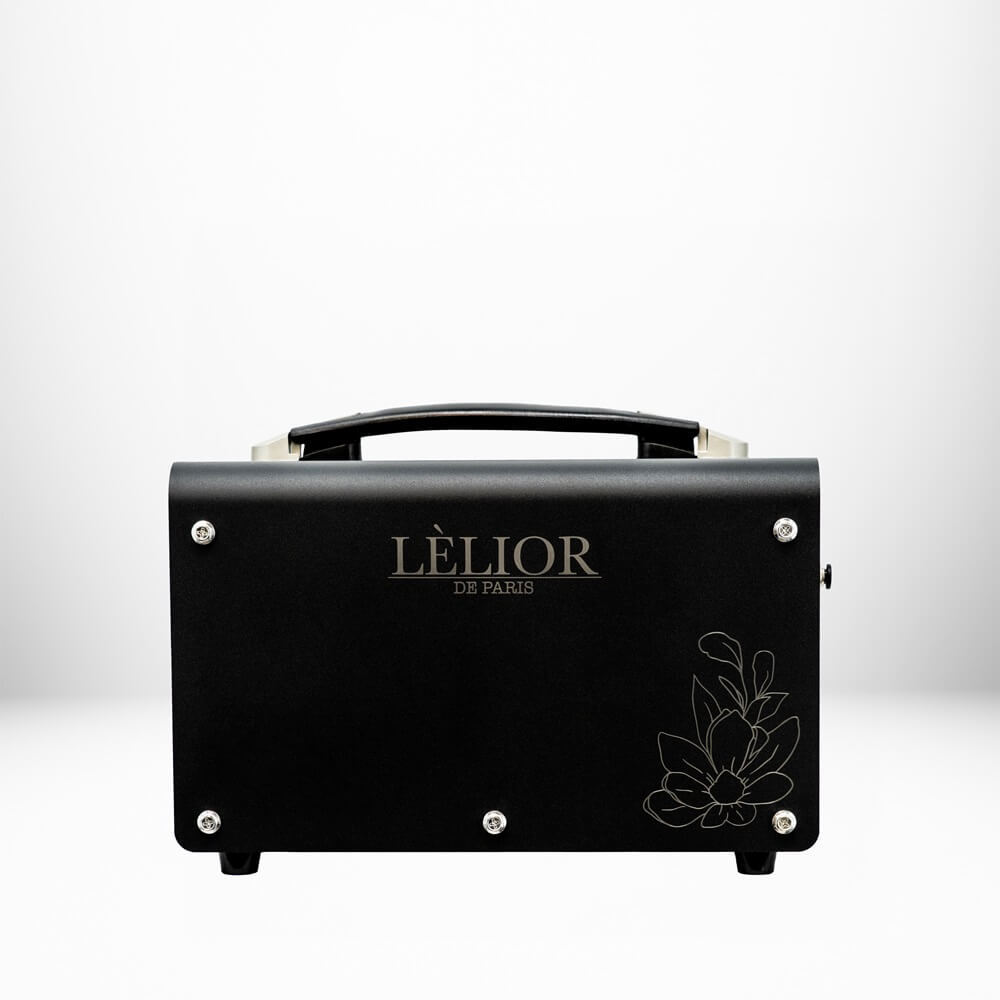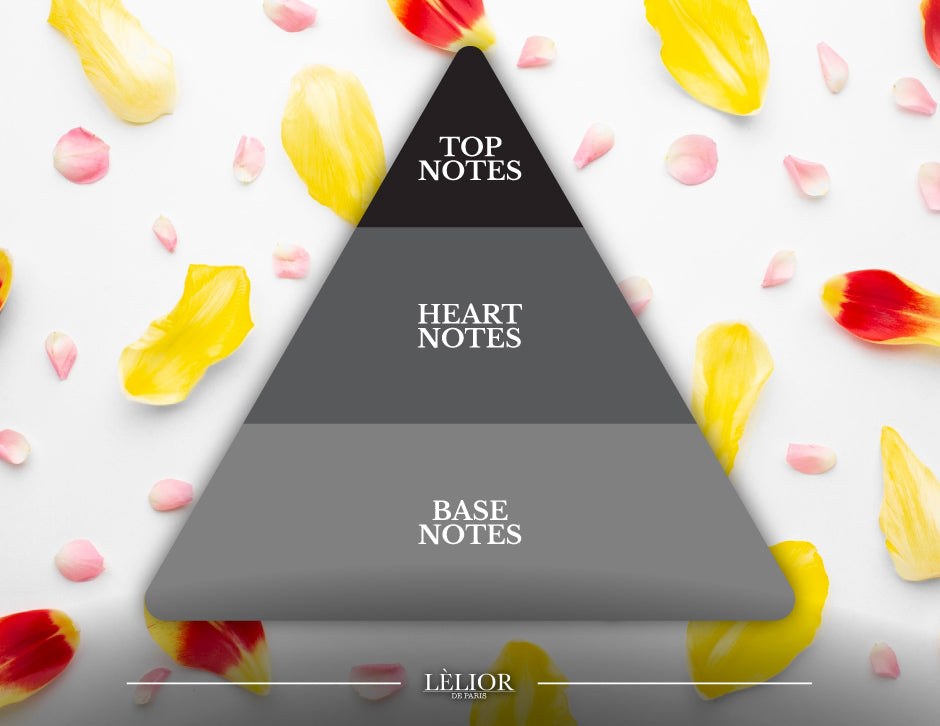Fragrance notes or perfume notes can be likened to the colors on an artist’s palette, which together create a masterpiece. Each fragrance note contributes unique characteristics to the composition, just as each color contributes to the overall visual impact of a painting.
So what are fragrance notes? Fragrance notes are the individual components of a perfume that, when combined in a certain concentration, create an overall scent. These notes can be classified into three categories: top notes, middle notes, and base notes. This article explores the basics and composition of fragrance notes to help you choose a fragrance or perfume that is just right for you.
The Basics of Fragrance Notes
Perfumers use a wide range of natural and synthetic fragrance notes to build a perfume. These notes are chosen from different parts of the fragrance wheel and can be grouped into top notes, middle notes (heart notes), and base notes. But what exactly do top, middle, and base notes mean?
Top Notes
Top notes are the lightest and most volatile of all the fragrance notes. They make up the first impression of a fragrance, forming its initial olfactory signature.
The top note is often made up of citrus or spicy scents that evaporate quickly once applied to the skin, lasting 5-15 minutes. Popular top cologne notes include bergamot, grapefruit, lemon, orange zest, cardamom, lavender, jasmine sambac, and peppermint.
Middle Notes (Heart Notes)
The middle, or heart, notes form the body of a perfume composition. These come through after the top note evaporates and typically last 3-5 hours on your skin. Common heart notes in perfumery include floral notes like rose, jasmine, carnation, and ylang-ylang.
Fruity scents such as peach, apple, blackcurrant, and pineapple are popular. Spicy notes such as cloves, nutmeg, and cinnamon can also be used as a middle note.
Base Notes
The base notes in perfume form the foundation of fragrance composition and provide it with staying power on your skin. These are usually richly aromatic ingredients that last for 8 hours or more after application to the skin.
Common examples of base notes used in perfume-making include sandalwood, cedarwood, patchouli, vanilla, tonka bean, and musk. These base note scents create a lasting, woody, and musky aroma.
The various perfume levels combine to create a unique scent experience. It is important to note that each perfume note will affect the overall composition differently depending on the other ingredients used in the blend.

Fragrance Notes and Composition
The art of perfumery lies in the skillful blending and harmonizing of these perfume notes to create a captivating olfactory experience. Perfumers often use various techniques to achieve the desired effect, including dilution, layering, distillation, and vaporization. This skillful blending process is what is described as a fragrance accord.
Fragrance Accords
A fragrance accord combines several scent notes to form a unique olfactory experience. The perfumer can adjust each scent note’s sweetness, spiciness, and intensity to create different accords with distinct characteristics. Each fragrance accord is designed to evoke an emotion or mood in the wearer.
For example, a floral perfume accord could have different flowery scents such as jasmine, rose, and ylang-ylang blended perfectly. Another popular example is the oriental accord, which combines sweet notes like vanilla with woody and musky base notes to create a warm and sensual aroma.
Fragrance Families
Fragrance families are another important concept used in perfume composition. These refer to broad groupings of scents based on their common characteristics. Examples include floral, fruity, woody, oriental, and fresh/aquatic families. These different scent profiles often inspire perfumers when creating a new perfume.

Exploring Fragrance Notes in Different Perfume Categories
Fragrance notes can create various perfume categories, such as floral, citrus, oriental, woody, gourmand, and aquatic scents. Let’s look at some popular scent notes in each category and their effect on the overall composition.
Floral Perfume
Flowery scents are the dominant fragrance notes in floral perfumes. Popular examples include jasmine, rose, lily of the valley, tuberose, and lilac. These fragrances create a light and airy feel, making them perfect for spring and summer. For added complexity, floral perfumes also often contain green notes such as galbanum or grassy herbal notes like lavender.
Lilas Noir by Lelior is a beautiful example of a floral scent. This sophisticated scent combines top notes of lilac and bergamot with woody base notes (sandalwood).
Citrus Perfume
Citrus scents are usually made up of top notes to provide an effervescent freshness to a perfume composition. Popular citrus notes in perfumery include lemon, bergamot, grapefruit, mandarin, and orange. These scents can be combined with herbal or woody notes to create a brighter and more modern scent.
For a rich citrus fragrance, Le Chemin by Lèlior combines top notes of citrus and green tea with heart notes of laurel leaf and lemon blossom. The base notes of sandalwood add warmth to round out the scent profile.
Oriental Perfume
Oriental perfumes are warm and sensuous thanks to the spicy, sweet, and woody ingredients used in their composition. Examples include amber, incense, patchouli, vanilla, musk, and sandalwood. Oriental fragrances often contain floral notes for added sweetness and complexity.
For a classic oriental scent, Lèlior’s Aventadora is an intense and mysterious fragrance. It features top notes of bergamot and blackcurrant with heart notes of patchouli, pink berries, and birch. The base notes of musk and vanilla give the scent a warm and inviting feel.
Woody Perfume
Woody perfumes typically feature resinous ingredients like cedarwood, patchouli, and sandalwood. These notes provide a deep earthiness that is perfect for colder weather. Woody scents can be combined with floral or fruity notes to create a more subtle and complex scent.
Lèilor’s Tulum Fragrance is a perfect example of a woody scent. It features top notes of jasmine and green leaves combined with heart notes of violet and iris. The base notes of Australian sandalwood and cardamom provide a warm and comforting finish.
Gourmand Perfume
Gourmand perfumes are deliciously sweet thanks to dessert-inspired ingredients like caramel, chocolate, coffee, and vanilla. These fragrances often contain fruit notes such as raspberry, apple, or pear for added complexity and depth. Gourmand scents are perfect for those who love sweet and indulgent perfumes.
Tobacco Vanille by Lèlior is a perfect example of a gourmand scent. This fragrance has a top note fragrance of tobacco and spices with heart notes of Tonka bean, cocoa, and vanilla. The woody base notes add an earthy depth to the scent profile.

Fragrance Notes and Personal Preferences
Our sense of smell is highly subjective, so it’s important to consider individual perfume preferences when selecting a scent. Some prefer lighter and fresher scents, while others prefer more intense fragrances. It can also be helpful to explore different fragrance notes across different perfume categories to discover new favorites.
For example, some blends may contain a base note of musk and a heart note of rose. While this perfume will suit those who like deeper fragrances, the same blend can be toned down with lighter tops and floral notes for those who prefer fresher scents.
Similarly, a woody scent may be combined with floral or fruity notes to create something more complex and interesting. This is why exploring different fragrances is important to find the perfect scent for your preferences.
Here are 5 tips for selecting perfume fragrances:
Experiment with Single Note Fragrances
Single-note perfumes focus on one primary fragrance note, allowing you to explore and identify your preferences easily. You can experiment with single-note fragrances such as vanilla, lavender, or bergamot and take note of the ones you find most pleasing.
This will help you become more aware of the specific notes that appeal to your senses and guide you in confidently selecting complex fragrances.
Create a Fragrance Notes Chart
Creating a perfume notes chart can be a helpful tool for exploring different perfume categories and finding the ones you like. Write down the specific fragrances you like from each family and the base, heart, and top notes that appeal to your senses. Keep track of your findings on a chart and refer to it when selecting new scents.
This will help you become more familiar with the nuances of different fragrances and make informed decisions when shopping for perfumes.
Pay Attention to Base Notes
Base notes are considered the foundation of a perfume composition and often have longer-lasting effects than other notes. Examples include sandalwood, patchouli, cedarwood, vanilla, musk, and amber. When selecting a new scent, pay special attention to the base notes and ensure they are pleasing to your senses.
Pay Attention to Concentration Levels
Different perfume concentrations will affect the overall strength and longevity of a fragrance. Parfum has the highest concentration level (between 20-30%) and provides the strongest smell with longer-lasting effects. Eau de parfum is considered mid-range (15-20%), while eau de toilette is lighter (5-15%) and less expensive than other options.
Try It Before You Buy
Sample fragrances before purchasing to better understand how they smell on your skin. This will also help you determine if the scent is too strong or light for your liking and avoid unpleasant surprises.
Conclusion
Perfumes offer a wide range of fragrances that can be used to create unique and personal scent experiences. Exploring different families of perfume fragrances, from citrusy and floral to woody and gourmand notes, is the best way to find scents you love.
When selecting perfumes, paying attention to base notes, concentration levels, and individual preferences is important to making an informed decision. With these tips and some experimentation, you can more easily identify the fragrances you like and create an even more enjoyable fragrance experience.










Magnificent explanation. I have learned a lot. I whish I knew this a year ago.
Me encantó su nota, supera bien realizada, explicativa y con ejemplos.